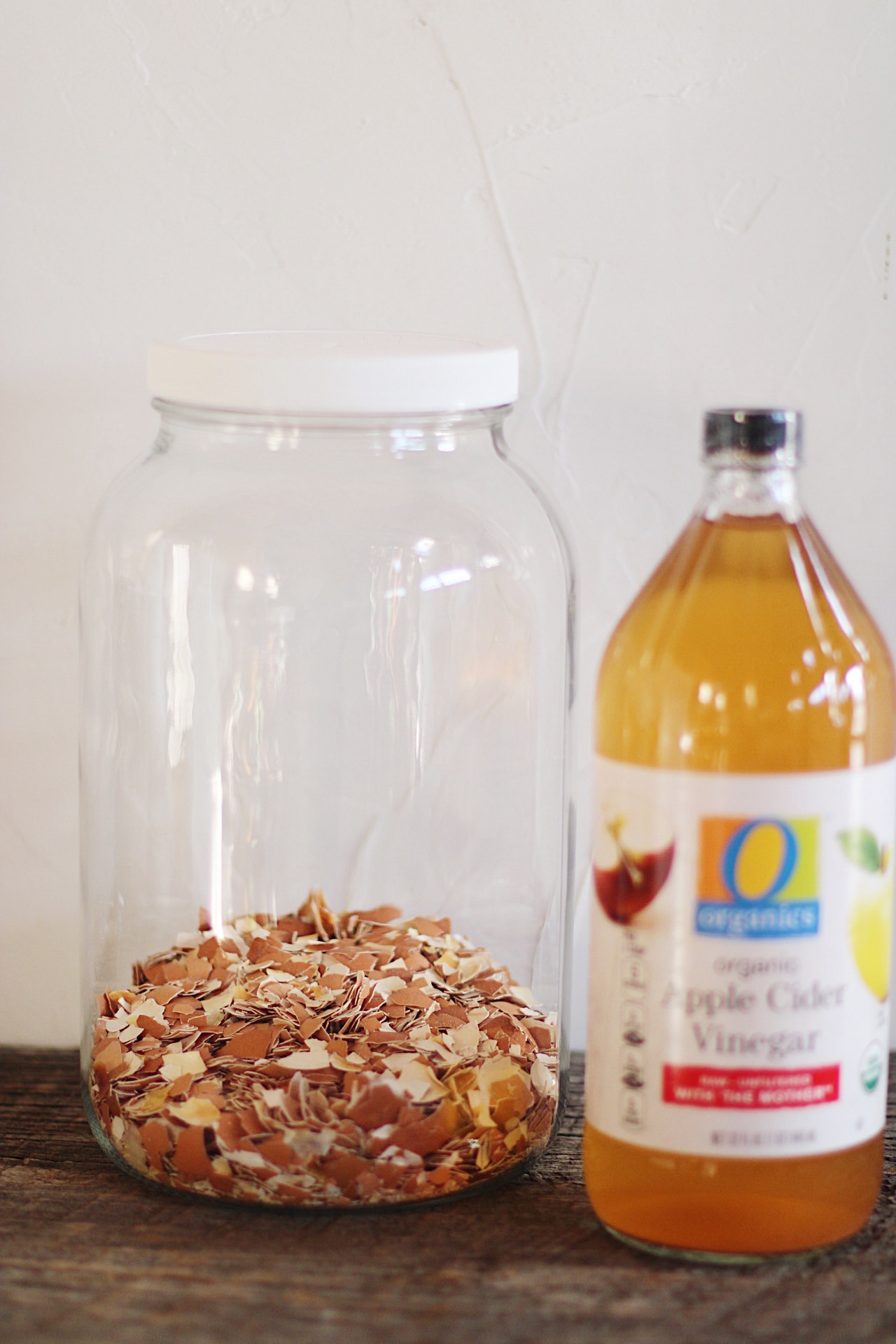
Eggshell Extract or WCA
Last week I started a little blog series on easy homemade regenerative inputs for your farm by explaining what leaf mold tea – or “JMS” a la JADAM – is as well as how to make and use it. Leaf mold tea is great for boosting the amount of biological life (bacteria, protozoa, fungus, etc) in your soil and ultimately helping loosen it up if it has been compacted from tillage or has poor drainage. That’s what we refer to as a “biostimulant”. But leaf mold tea does not add any nutrition to your soil (i.e., minerals/fertilizer).
Today I want to introduce you to one of my favorite homemade regenerative inputs for adding a vital mineral nutrient to your soil: calcium extracted from eggshells. This input comes straight out of the Korean Natural Farming (KNF) handbook, where it is referred to as WCA (shorthand for Water-Soluble Calcium). Or, if you are not that into acronyms (and boy are there are lot of acronyms in the world of KNF and JADAM!), you can just call it eggshell extract. I love it because it is SO easy and it makes all my spent eggshells feel really useful (big egg-eating household over here!).
Calcium is critical to the formation of strong cell walls in plants as well as helping to facilitate the absorption of other minerals and nutrients to ensure disease resistance and healthy growth. If your flower crops do not have access to enough soluble calcium, the stems of your flowers will be weak. A prime example of this that many flower farmers will know is split stems on anemones, which is one of the reasons I started using the WCA eggshell extract in the first place!
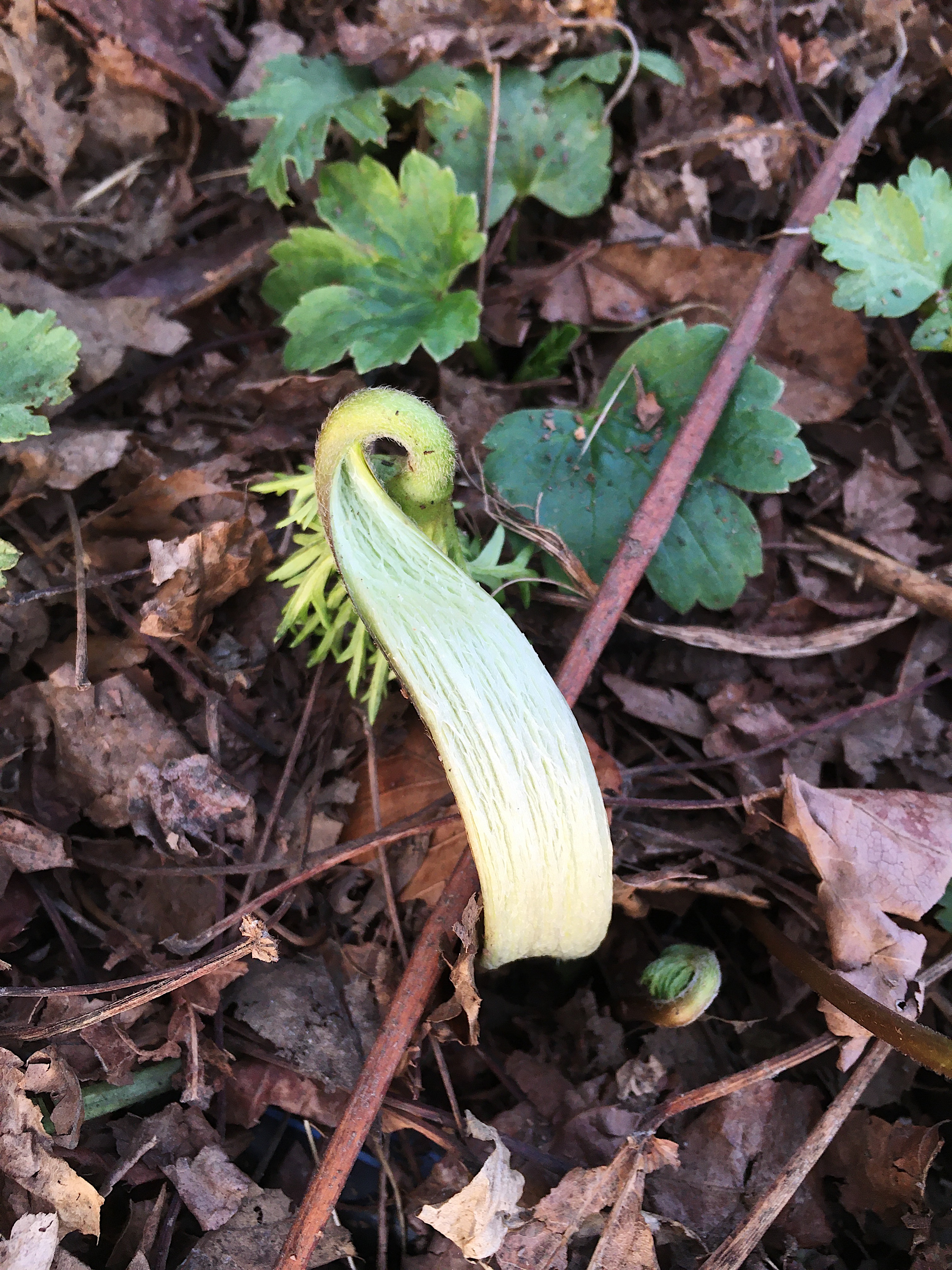
Calcium also plays a critical role in soil structure, helping push soil particles apart for better aeration and drainage. You will want to make sure to soil test regularly (I soil test each August at my farm) so you can keep an eye on mineral levels. Make sure the soil lab/test you choose will do a full spectrum on minerals, not just the macro nutrients, NPK. For calcium, look for about 68% saturation in your soil. A little more or a little less is not cause for concern, but major deviations should be addressed. In certain parts of my farm, there is only 47% saturation of calcium and the soil there is “tight” with poor drainage. Adding WCA eggshell extract is slowly helping to loosen them up. I’ve also found drenching chickweed infested beds with eggshell extract WCA is one way to fight this weed that is there to mine calcium from the subsoil to add it to the top soil as nature tries to bring soil into balance through species successioning. By adding the eggshell extract, I seem to have been able to help nature skip ahead and the chickweed died out. But more on that later…
One thing I did not know when I first started using eggshell extract around the farm was that calcium is taken into plants almost exclusively via transpiration. It is not very mobile when applied to plant tissue itself. In other words, it is best to use WCA eggshell extract as a soil drench at the roots of the plant rather than a foliar feed sprayed onto the leaves. That being said, I have used it regularly as part of my routine foliar feed for dahlias and it seems to still be effective. Several respected resources for KNF reference using it in foliar sprays as well. So just consider your objective when using it in order to choose the best delivery method; when in doubt, just use it as a drench.
One other note here: Tony of Bare Mountain Farm, who has continually and generously mentored me in KNF practices, recently mentioned that I might want to try another variation of this extract process that uses charred bones rather than eggshells so the resulting liquid would contain both calcium and phosphorous, which is even better for plants in the flowering stage of growth. I have not tried this preparation myself yet (somehow bones scare me <shrug>), but Tony has a great video on it here that you can check out if you’re curious.
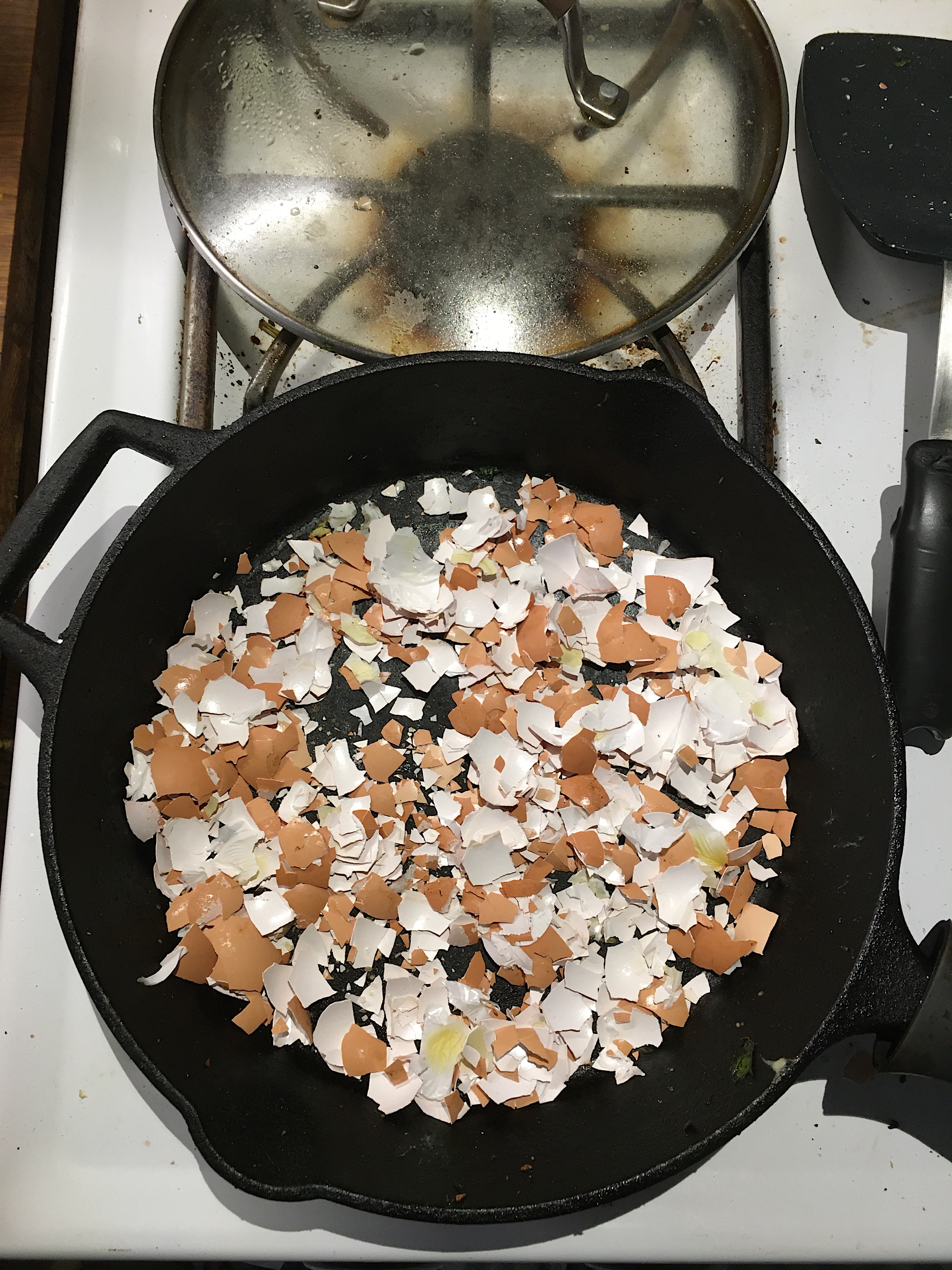
EGGSHELL EXTRACT or WCA
Goal: To extract the calcium in eggshells and suspend it in a liquid soluble form that can then be applied to the soil as a drench. Helps strengthen weak stems and loosens compacted soils, among other things.
Ingredients
Eggshells (try starting with a dozen; scale up or down as desired after that)
Organic raw apple cider vinegar or organic brown rice vinegar (about quart if you’re using a dozen eggs)
Tools
Large glass jar, such as a quart or gallon canning jar
Paper towel or cheese cloth
Large rubber band
To Make:
Place the eggshells in a heavy skillet over medium heat to start. Use the back of a spatula to crush the shells up into smaller pieces. No need to go crazy with crushing at this stage. Just break them up so heat gets around all the pieces more evenly. After about four or five minutes on medium heat, lower the heat to low and put a lid on the skillet. Let the shells sit on low heat until they are toasted golden brown. This usually takes about 10-12 minutes, but sometimes I walk away and get busy and they’re on the stove for 30 minutes and it doesn’t seem to matter.
Turn off the heat and let cool completely. Once cool, crush the eggshells into even smaller pieces. You can do this with the back of the spatula again or you can put the shells into the glass jar, screw on the lid tightly, and give them a real good shake. Just don’t add the vinegar yet!!
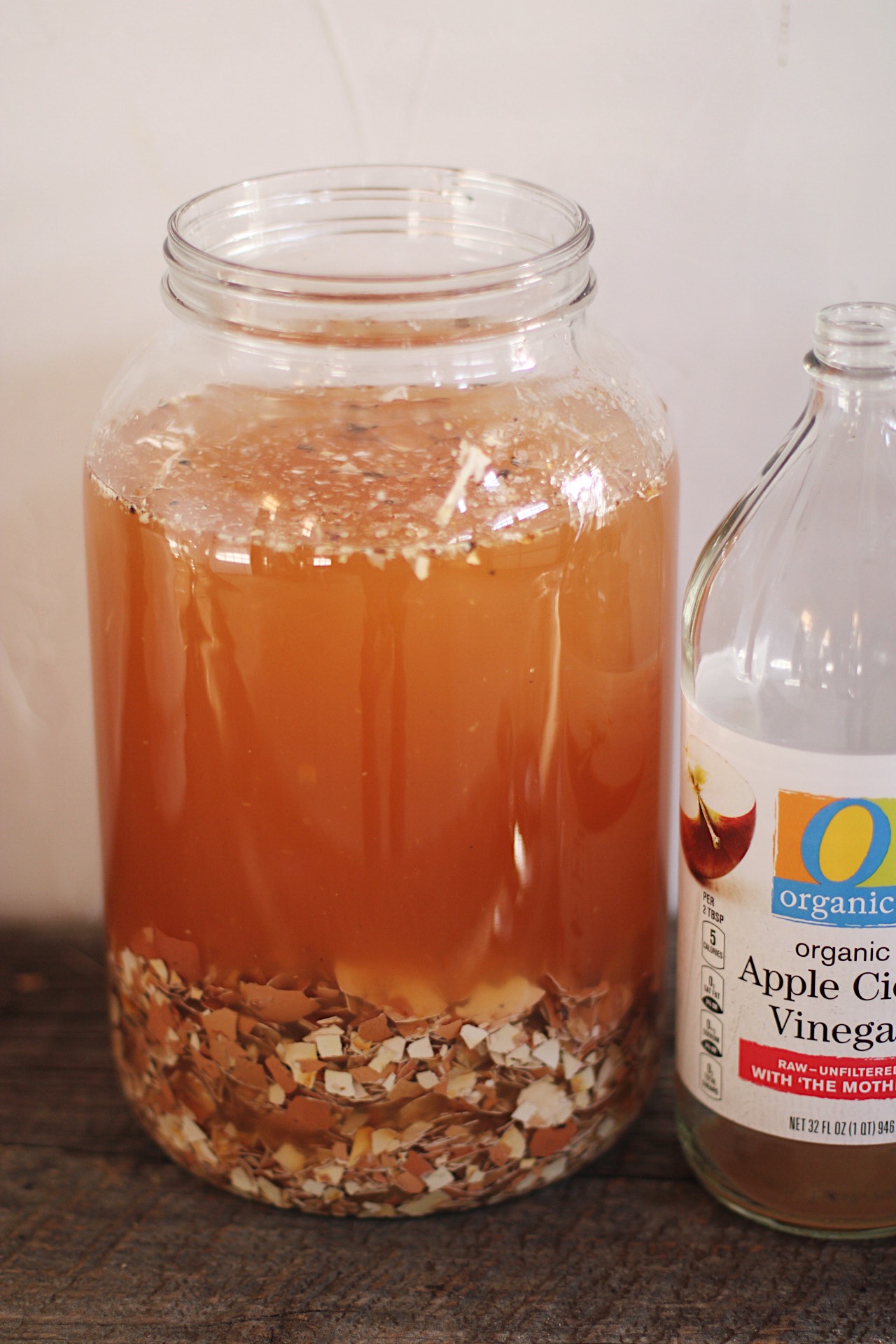
After the eggshells are toasted and placed in the bottom of the jar, it’s time to add the vinegar. You are looking for a ratio of 1 part eggshells to 10 parts vinegar. To give you some idea, a dozen medium-sized eggshells usually is a good amount for a quart-sized jar to achieve that 1:10 ratio. Slowly pour the vinegar over the eggshells, stopping about halfway in case there’s a quick chemical reaction that creates super fizz. Once you’re sure nothing crazy is going to happen, fill the jar up the rest of the way, leaving about one inch of space at the top so bubbling won’t cause it to overflow.
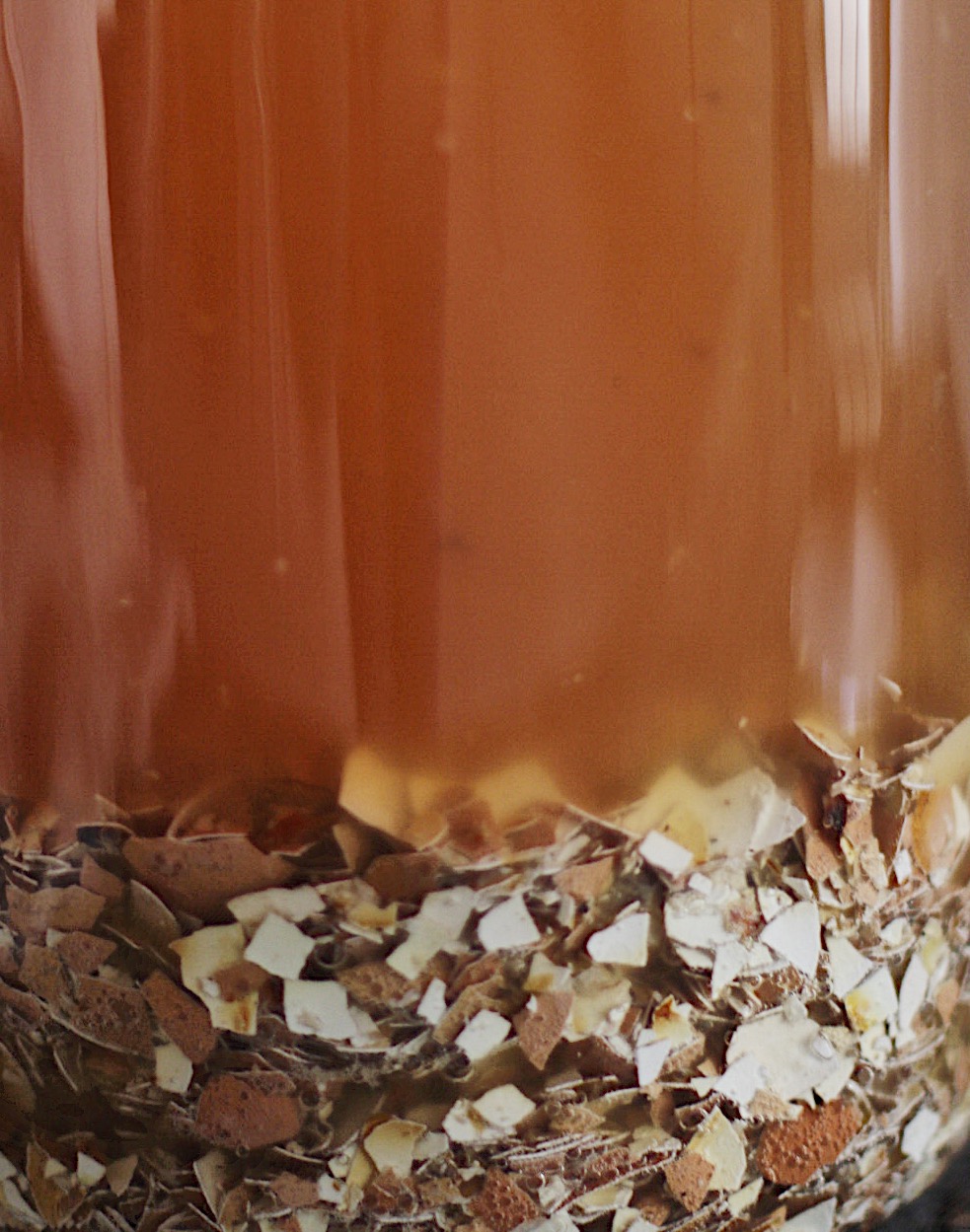
You’ll notice rapid bubbling almost immediately. This is the vinegar extracting the calcium. Place a paper towel or cheese cloth over the mouth of the jar and secure with the rubber band. Never put the lid on the jar when in the process of making WCA eggshell extract as it creates a lot of gas that needs to escape.

Let the jar sit for 7-10 days. If you are in a hurry, you can decant the extract after just 5 days but it may not be as strong. If you totally forget about the jar for a month, not to worry. It’ll still be good to use. When you’re ready to call the extract “done”, strain the liquid through cheese cloth or a fine mesh strainer to catch any remaining pieces of eggshell. Place liquid in a sealable container with a tight-fitting lid. I usually just pour mine back into the same jar in which it was brewed. Label the jar so you remember what it is and when it was made. You’ll notice that while there will still be a hint of vinegar smell to the extract, most of the typical “zip” of vinegar is gone. Thus you won’t burn your plants when applying it.
What’s nice about this particular extract is that it is totally self-stable and does not “expire”. So you can make a big batch over the winter here and keep using it all throughout this coming season! I keep my jar in my flower cooler so it’s always handy at the farm for use. It doesn’t technically need to be refrigerated, but you do need to keep it away from sunlight.

To Use: Dilute at a ratio of 1:500 to 1:1000. Here at my farm, I typically use 1 teaspoon of the eggshell extract for each gallon of water which is a ratio of about 1:757. It can be applied to the soil with a watering can or used as a foliar feed in a sprayer. You can mix it with leaf mold tea to apply both at once.
Never use pure concentrated eggshell extract on your planting beds as that will really throw your soil and crops off balance!
If you’re more of a visual learner, here’s the video by Chris Trump that I used originally to learn how to make eggshell extract or WCA.
Come back to the blog soon to learn about a third easy (and powerful!) homemade regenerative input for your farm: nettle tea. Woot! In the meantime, get your regenerative flower farming fix by reading past posts here on this blog.

This is awesome! Thank you so much for sharing.
This is awesome. Homeschool lesson and feeding flowers all in one. Yes!!
Thanks so much! This has come into my view at just the right time – fingers crossed. 🌻💛
Very interesting! I will try this.
What is the heating step for? To kill any sort of living bacteria on the egg shells?
There is a thin membrane on the inside of the egg shells that are difficult to remove and can cause the end product to become putrid if not removed prior to adding the vinegar. I think heating does multiple things to the egg shells (perhaps making the Ca more available to the chemical reaction that takes place ) however, heating also dries up the membrane making it easier to separate from the shell.
I cook the eggshells outdoors on a cast iron over the bbq. I’ll “toss” the egg shells into the air allowing a breeze to blow the dried membrane away while the heavier shells fall back into the pan.
Cheers!
Can’t wait to try this. Thank you for such an easy to follow guide. Love your
No- Till Market Garden podcast!
How often do you use the drench, i.e., once a week? once a month? Thank you! Very easy to follow.
I’ve been wanting to try this. Thanks so much!
Thank you so much for sharing. Saving link and adding your info to my gardening research notes.
I have high salt content, high potassium and very high phosphorus levels. Will add to my problem? I’m trying to go no till, but I’m trying figure out how to deal with these high levels.
That sounds to me like you got a bad batch of compost! Compost that has not been well-aged and made with too much manure can be pretty disastrous for your garden. Ask for analysis results for any compost before you buy it. That way you can avoid this in the future.
You native soil is likely in better balance than that. Be careful when you take a soil sample to scrape away all the compost at the surface before taking the soil core for sampling, otherwise your test results will be skewed. If I’m assuming incorrectly that you’ve had compost on your beds and what you’ve outlined is truly the composition of your native soil, then you’ll likely need to work with a soil consultant to figure out how to bring balance.
How often do you apply this?
Whenever I feel it is needed in my farm’s production and soil systems. Certain crops tend to crave more calcium than others (i.e., dahlias and anemones) so I’ll use it in foliar feeds for them on a near-weekly basis. I use WCA when starting seedlings and setting out transplants by mixing it in a flat bottomed tub with other natural inputs like leaf mold tea, kelp, etc and letting the trays sit in the tub and soak up the mixture to saturate the soil. And I use it as a soil drench around the farm where soils are “tight” and not draining properly. It’s a very useful input to have on the farm!
Thank you so much for sharing this knowledge. Am super curious now about JADAM. Buying the JADAM book. 💚
What is the application volume per square foot?
The rate varies on what you are trying to accomplish and if it is being used as a foliar feed on plants or if it will be used to drench the ground. I mix 1 tsp with 1 gallon of water and then see how far it goes depending on how it is being applied. A gallon used as a soil drench usually covers about 25 square feet. A gallon used as a foliar spray can cover 1000 square feet.
Thanks for the info on WCA. I made my batch but one question…. I have city water. Can I use that for dispersing the WCA or should I let that water sit for 24 hours as you suggested for Leaf Mold Tea?
You could use the water straight out of the tap. The WCA is not “alive” like the leaf mold tea so the chlorine in the water won’t harm anything in it.
I have been using the cooled water I boil eggs in, undiluted, for several years whenever my flowers and vegetables have slowed making new buds. I usually have a new crop of buds within a week or so. I will try using this method now, too. Thanks.
So excited to try this! Can I use regular white vinegar?
I think so. I’ve only ever used apple cider vinegar and only ever seen others reference that but I don’t see why you couldn’t use white vinegar.
Can I still make this if my eggshells got slighly burned?
Yep, absolutely!
Very informative and motivating.
I love learning from you.
Did you already write a book?
Would buy it without hesitation.
Thank you Jennie!
I’m wondering if you can add the roasted eggshells to homemade fish emulsion as it’s gearing up (along with the fish guts and bones, sawdust, molasses etc)? I’d love to have calcium along with the nitrogen boost of the fish emulsion. Or do you need to have the vinegar draw out the calcium from the eggshells to be effective? Or could you add a little WCA directly to the fish emulsion as you apply it?
The vinegar is needed to draw the calcium out of the eggshells. You could mix completed WCA with fish emulsion before apply, yes.
I’m curious what kind of injector you are using with your drip irrigation system. I am researching them now and looking into the Mazzei, Mixrite, Chapin, Ez-Flo systems. Do you have any recommendations based on your experience using them with regenerative inputs?
Regards,
Meg.
Hi Meg – We use a Mixrite.